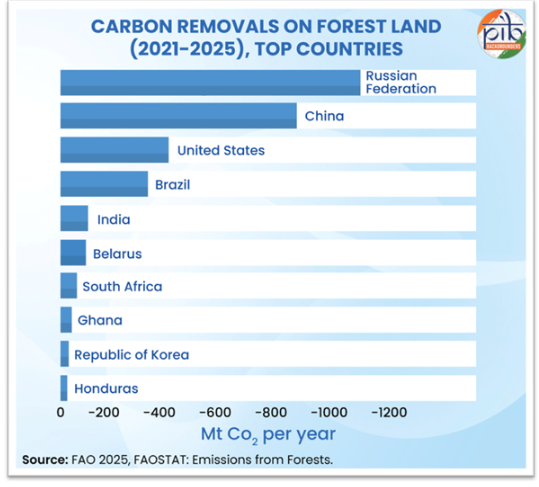From Afforestation to Climate Leadership
Introduction:
According to the FAO’s Global Forest Resources Assessment (GFRA) 2025, India now ranks 9th worldwide in total forest area and maintains its 3rd position in net annual forest area gain.
-
- The country has also secured the 5th position among the top global carbon sinks. This achievement underscores India’s unwavering commitment to the vision of Lifestyle for Environment (LiFE) and sustainable growth under Viksit Bharat @2047.
- India has also maintained its3rd position globally in the annual net gain of forest area.
Global Forest Resources Assessment (GFRA):
The Global Forest Resources Assessment is the only worldwide assessment based on official national data. FRA identifies two broad categories of forest:-
1. Naturally regenerating
2. Planted.
Within these broad categories, it identifies primary forests – those with only native species – as a subcategory of naturally regenerating forests. Under the subcategories of planted forests, it identifies plantation forests (for example, rubber) and other planted forests (forests that are planted but do not satisfy the criteria of a plantation).
India in the Global Forest Context (GFRA 2025):
-
- Global forest cover equal to 4.14 billion hectares (32% of land).
- Europe (25%) holds the largest area. South America (49%) has the highest proportion of forested land.
- Five nations — Russia, Brazil, Canada, USA, and China hold 54% of total forest cover.
- India contributes ~2% of global forests, marking steady progress in afforestation and sustainable forestry.
India’s Success in Expanding Planted Forests
| Category | Global Rank | India’s Coverage | Remarks |
|---|---|---|---|
| Bamboo Forests | 1st in Asia (2nd globally) | 11.8 million ha | 70% of Asia’s bamboo area is key livelihood source. |
| Rubber Plantations | 5th | 831 thousand ha | Contributes to 10.9 million ha globally. |
| Agroforestry | Among Top 2 | ≈39.3 million ha (shared with Indonesia) | Accounts for 70% of global agroforestry area. |
India’s large-scale bamboo, rubber, and agroforestry programmes have expanded green cover while enhancing livelihoods and soil fertility.
India’s Forest Status (ISFR 2023)
| Parameter | Status |
|---|---|
| Total Forest Cover | 7,15,343 sq. km (21.76% of India’s land area) |
| Top States | Madhya Pradesh (77,073 sq km), Arunachal Pradesh (65,882 sq km), Chhattisgarh (55,812 sq km) |
| Mangrove Cover | 4,992 sq km — majorly in A&N Islands, Gujarat, Maharashtra, West Bengal |
| Protected Areas | 106 National Parks, 573 Wildlife Sanctuaries, 115 Conservation & 220 Community Reserves |
Global Carbon Sink & India’s Leadership
-
- India ranked 5th among global carbon sinks, absorbing 150 Mt CO₂/year (2021–25).
- Asia’s carbon removal rose to 0.9 Gt CO₂/year, driven by afforestation in India and China.
- India contributes 9% of global wood removals, ranking 2nd worldwide (2023).
- Forest carbon sinks in Europe and Asia collectively remove 2.3 Gt CO₂/year, offsetting deforestation emissions.

Government Initiatives Enhancing India’s Green Footprint:
1. National Mission for a Green India (GIM)
-
- Launched under the National Action Plan on Climate Change (NAPCC).
- Targets:
- 5 million ha of new forest/tree cover.
- Improve the quality of another 5 million ha.
- Aims to restore ecosystems, enhance biodiversity and carbon sinks, and support 3 million forest-dependent families.
2. National Afforestation Programme (NAP)
-
- Focus: Regeneration of degraded forests and adjoining areas.
- Implemented through three-tier structure:
- State Forest Development Agency (SFDA)
- Forest Development Agency (FDA)
- Joint Forest Management Committees (JFMCs)
3. Mission LiFE (Lifestyle for Environment)
-
- Global call for sustainable living launched by India.
- UN Environment Assembly adopted LiFE resolution in 2024.
- MeriLiFE Portal enables citizens’ green pledges.
- “Ek Ped Ma Ke Naam” campaign promotes tree plantation linked with emotional appeal for nature and motherhood.
4. Budgetary Push (2025–26)
-
- MoEFCC allocation: ₹3,412.82 crore (↑9% from 2024–25).
- Revenue expenditure: ₹3,276.82 crore (96% of total).
- Focused on afforestation, biodiversity protection, and climate adaptation.
Deforestation and Net Forest Change
-
- India’s net forest gain (1990–2025) reflects success in reversing degradation.
- Reduced deforestation and rising afforestation rates have improved ecological balance.
- FAO notes that global net forest loss fell by over 60% since 1990, with India among top contributors to this positive trend.
Conclusion:
As the world strives to combat climate change, India’s expanding green footprint lights the path toward an equitable and eco-conscious Viksit Bharat @2047.
Spread the Word
